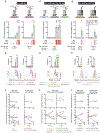Designed protein logic to target cells with precise combinations of surface antigens
- PMID: 32820060
- PMCID: PMC8085813
- DOI: 10.1126/science.aba6527
Designed protein logic to target cells with precise combinations of surface antigens
Abstract
Precise cell targeting is challenging because most mammalian cell types lack a single surface marker that distinguishes them from other cells. A solution would be to target cells using specific combinations of proteins present on their surfaces. In this study, we design colocalization-dependent protein switches (Co-LOCKR) that perform AND, OR, and NOT Boolean logic operations. These switches activate through a conformational change only when all conditions are met, generating rapid, transcription-independent responses at single-cell resolution within complex cell populations. We implement AND gates to redirect T cell specificity against tumor cells expressing two surface antigens while avoiding off-target recognition of single-antigen cells, and three-input switches that add NOT or OR logic to avoid or include cells expressing a third antigen. Thus, de novo designed proteins can perform computations on the surface of cells, integrating multiple distinct binding interactions into a single output.
Copyright © 2020 The Authors, some rights reserved; exclusive licensee American Association for the Advancement of Science. No claim to original U.S. Government Works.
Conflict of interest statement
Competing interests:
M.J.L., S.E.B., A.I.S., J.B., R.A.L., M.G., C.E.C., S.R.R., and D.B. are inventors on patents related to this work. M.J.L., S.E.B., A.I.S., R.A.L., M.J.B., S.R.R., and D.B. hold equity in Lyell Immunopharma. D.B. holds equity in Sana Biotechnology. M.J.L., S.E.B., R.A.L., M.J.B., and S.R.R. are employees of Lyell Immunopharma. A.I.S. is a consultant of Lyell Immunopharma.
Figures




Comment in
-
When de novo-designed protein logics meet CAR-T therapies.Cell Res. 2020 Nov;30(11):946-947. doi: 10.1038/s41422-020-00419-z. Cell Res. 2020. PMID: 32978606 Free PMC article. No abstract available.
Similar articles
-
Programmable single-cell mammalian biocomputers.Nature. 2012 Jul 5;487(7405):123-7. doi: 10.1038/nature11149. Nature. 2012. PMID: 22722847
-
Construction of a fuzzy and Boolean logic gates based on DNA.Small. 2015 Apr 17;11(15):1811-7. doi: 10.1002/smll.201402755. Epub 2015 Jan 7. Small. 2015. PMID: 25565140
-
A CRISPR/Cas9-based central processing unit to program complex logic computation in human cells.Proc Natl Acad Sci U S A. 2019 Apr 9;116(15):7214-7219. doi: 10.1073/pnas.1821740116. Epub 2019 Mar 28. Proc Natl Acad Sci U S A. 2019. PMID: 30923122 Free PMC article.
-
Biosensors with built-in biomolecular logic gates for practical applications.Biosensors (Basel). 2014 Aug 27;4(3):273-300. doi: 10.3390/bios4030273. eCollection 2014 Sep. Biosensors (Basel). 2014. PMID: 25587423 Free PMC article. Review.
-
What Can De Novo Protein Design Bring to the Treatment of Hematological Disorders?Biology (Basel). 2023 Jan 20;12(2):166. doi: 10.3390/biology12020166. Biology (Basel). 2023. PMID: 36829445 Free PMC article. Review.
Cited by
-
Recent advances in de novo protein design: Principles, methods, and applications.J Biol Chem. 2021 Jan-Jun;296:100558. doi: 10.1016/j.jbc.2021.100558. Epub 2021 Mar 18. J Biol Chem. 2021. PMID: 33744284 Free PMC article. Review.
-
Modular Chimeric Antigen Receptor Systems for Universal CAR T Cell Retargeting.Int J Mol Sci. 2020 Sep 30;21(19):7222. doi: 10.3390/ijms21197222. Int J Mol Sci. 2020. PMID: 33007850 Free PMC article. Review.
-
The Progress and Prospects of Immune Cell Therapy for the Treatment of Cancer.Cell Transplant. 2024 Jan-Dec;33:9636897241231892. doi: 10.1177/09636897241231892. Cell Transplant. 2024. PMID: 38433349 Free PMC article. Review.
-
Engineering the next generation of cell-based therapeutics.Nat Rev Drug Discov. 2022 Sep;21(9):655-675. doi: 10.1038/s41573-022-00476-6. Epub 2022 May 30. Nat Rev Drug Discov. 2022. PMID: 35637318 Free PMC article. Review.
-
Synthetic receptors for logic gated T cell recognition and function.Curr Opin Immunol. 2022 Feb;74:9-17. doi: 10.1016/j.coi.2021.09.003. Epub 2021 Sep 24. Curr Opin Immunol. 2022. PMID: 34571290 Free PMC article. Review.
References
Publication types
MeSH terms
Substances
Grants and funding
LinkOut - more resources
Full Text Sources
Other Literature Sources
Research Materials
Miscellaneous

